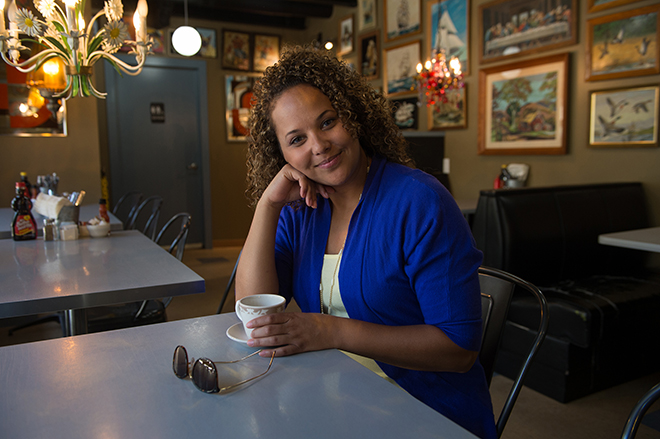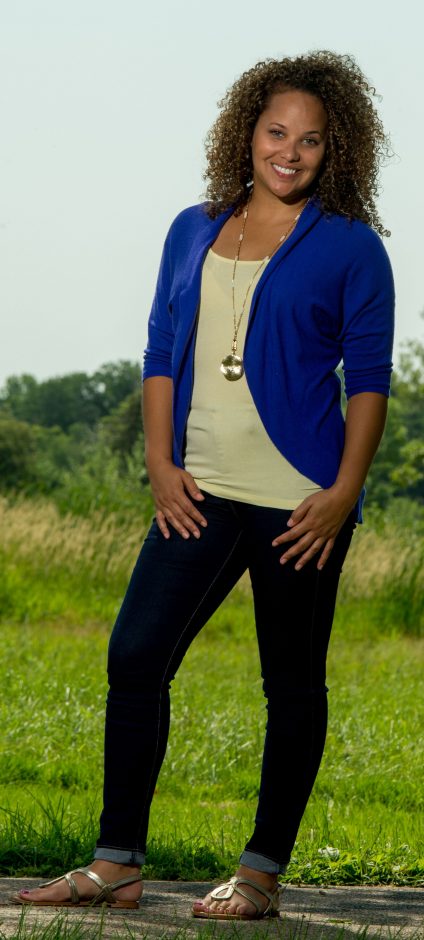From a path launched at Minnesota State Mankato, a Teacher of the Year emerges

Today she’s Minnesota’s Teacher of the Year, an icon of confidence. An inspiration to teachers and students statewide as a champion for minority students in particular to succeed in in their schooling and life.
But when she was graduating from Minnesota State Mankato in 2001 with a biology degree, Jessica Davis was increasingly unsure of her plan to pursue medical science as a career. In fact, by graduation day, she had already decided she wasn’t into medicine.
Keep on mind, here was a Presidential Scholarship recipient. A member of the CSET Dean’s advisory board. Ready to graduate and …. she found herself not into medicine anymore.
Fortunately, she had University members who had exposed her to more. She credits Maria Baxter, head of African American affairs at Minnesota State Mankato, with launching her interest in minority affairs. Her calculus teacher, Bruce Mericle, instilling a love for math.
After graduating, she worked for a staffing agency (Jeane Thorn, owned by alum Mary Marso) and for William Mitchell College of Law. There, she realized she wanted back into education.
While working full-time, she attended Hamline University’s MAT program. “I chose math because though I loved all my experiences at Minnesota State Mankato and being part of the STEM programs, it was Dr. Bruce Mericle as my calc teacher that really helped me discover my love for math.”
Since 2009, she’s been at South St. Paul Secondary School, working primarily as a math teacher but also teaching some computer science. Her teacher-of-the year award noted her commitment to empowering students of color. The University’s emphasis on diversity played a role in shaping her outlook, she said. She hung out at the Intercultural Student Center and was the University’s first African-American homecoming queen.

“The thing that still sticks out for me when comparing all of my educational experiences since and including Minnesota State Mankato, is how very much supported I felt in Mankato. It seemed I had access to anything I needed and a team of people who were always available and willing to help. I am always excited when I learn that one of my students has chosen Minnesota State Mankato as their next academic adventure.”
Whose teaching inspires (or inspired) you?
First – my mom, also an alum (1971). She taught for 38 years in the Albany School District just north of St. Cloud. She is the one who set our academic expectations and showed all of my siblings and I how to navigate school. My oldest brother also followed in our footsteps and graduated from Minnesota State Mankato 2005/06-ish.
In high school – David Vaerst. He is a math teacher who hypothesized while I was still in high school that I would become a math teacher one day. I held out as long as I could. But then found an email waiting in my inbox on the first day of teaching in 2006 that simply said, “I told you so.”
At Mankato – Dr. Orville Ziebarth (Chemistry), Dr. Edward Williams (advisor, Anatomy), Dr. Michael Fagin (Cultural Diversity), Dr. Bruce Mericle (Calculus) – and so many more.
What kind of student were you, and do you see yourself in a certain type of student today? And how did you-as-a-student affect you-as-a-teacher?
I did well in school, but I didn’t always enjoy it. I think my experiences in high school and post-secondary informed my teaching in how I help students navigate what can sometimes be an overwhelming part of a person’s life. I do my best to continue conversations with students about what comes after high school and how their choices now can create opportunities and pathways for the future. Also, because I made a change in the direction of my career after college, I see myself as a role model on how to find the ways in which my students can best contribute to their communities while finding their own purposes in life.
What kinds of obstacles are out there that you had to overcome in order to be effective and enthusiastic about the work you do?
I think all of the work that our affinity groups are doing in the high school I teach (and serve as the advisor of the Black Pride Organization) demonstrate and articulate the obstacles encountered by and impacting the experiences of our black and brown students. It is through their shared vision and missions to support students of color in education by providing leadership opportunities and space for all to have a voice that I have found my own purpose and place in the world.
It seemed I had access to anything I needed.” — Davis on Minnesota State Mankato.
Life is funny in the way that it is constantly changing. I separated from my husband in 2016 after a 12-year relationship. During that time my job was the anchor that kept life moving forward; thus, my effectiveness and enthusiasm for my work evolved over time. I was simply doing what made me feel useful and needed. Students need representation. They need to be shown how to maneuver through life. They need the space to make mistakes and learn from them. When I can, I try to meet as many of those needs as possible.
You’re about to start another year of teaching with one notable difference: You are now Minnesota’s Teacher of the Year. How does receiving that honor feel? And how do you think it will affect the job you do in the classroom going forward?
This honor feels life altering. First, I am absolutely humbled to represent the 86,000 amazing teachers in a state that is known to value educational programing. Moving forward is still a mystery to me – in the most exciting way possible. I had never imagined having this kind of platform to make this kind of impact in the world. I’m doing everything I can to be in the moment and appreciate each opportunity that has presented itself. I’m looking forward to crafting a legacy of change, and I hope to continue making connections with others around the state (and country) who are doing similar work to advance equity in education by providing opportunities for all students to find their passion and fullest potential.
From there, who knows? Not even the sky is the limit.
Speak Your Mind